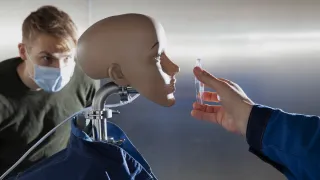The research into the spread of coronavirus has been joined by a robot that, unlike a person, can cough out a precisely specified and repeatable consistency of droplets and aerosols. The coughing robot helps determine the effect of masks and various air purifiers on the spread of droplets and aerosols. Measurements made with the robot are also used to verify the accuracy of computer simulations.
Since autumn 2020, a joint project by VTT, the Tampere University and THL has studied the mechanisms of the droplet and aerosol transmission of COVID-19 and the methods for reducing the risk of transmission. The droplets of a cough or sneeze dry quickly, but the remaining small particles may remain in the air for hours. Small aerosols are also formed when you breathe, talk and sing, for example. Business Finland supports the research with approximately EUR 300,000 in funding.
For the research project, an artificial human head has been built that can cough, sneeze and breathe to produce well-defined droplets and aerosols consisting of liquids and solids. The robot has been installed in VTT's test room where external factors such as temperature, ventilation and humidity can be determined precisely.
Measurements made with the robot are used to discover information such as how droplets and aerosols move and how the situation is affected by technical methods that reduce the risk of infection, including adequate and appropriately distributed ventilation, air filtration, air purifying and wearing masks.
“With this device, one of the things we can do is produce an aerosol size distribution that is fairly similar to the aerosols produced by a person coughing, sneezing or breathing”, says Topi Rönkkö, Associate Professor of aerosol physics at the Tampere University.
Simulations have already been run for different situations to demonstrate the impact of preventive measures such as masks in reducing the travel distance of a cloud containing droplets and aerosols produced by coughing. The project will use the measurements produced with the robot and test room to run more simulations in order to verify previous ones. In the project, the droplets coughed by the robot are also supplemented with surrogate viruses mimicking the SARS-CoV-2 virus that causes the COVID-19 disease in order to find out how the viruses travel in a given space. It also helps develop virological diagnostic methods for direct airborne measurements. This data is used to develop different methods for preventing the spread of COVID-19.
The project has combined its resources with two other Business Finland-funded projects investigating the spread of COVID-19 and ways to prevent its transmission. The business-driven, more extensive follow-up project that is currently being prepared aims to involve Finnish companies and achieve significant international business potential and exports.
“In this more extensive project, we aim to create research cooperation among a wide range of actors. In addition to the current pandemic, we are also amassing preparedness and expertise for future pandemics”, says Tamlink Oy's Jari Erkkilä, the director of an indoor air ecosystem shared by companies and research organisations.





